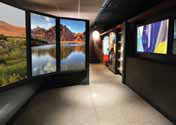If all of your facility’s video sources are going to live in one control room, your best option for distribution might be a multi-channel video player, like the Alcorn McBride Digital Binloop HD, which can provide all of the video for an entire facility from a single, easy to manage source. Video can be distributed across the facility using common network cabling via any number of video-to-Cat-5 converters. While the cabling may be similar to your other network infrastructure, it is important to keep these video lines separate from your network (since they normally can’t run through ethernet switches).
A visitor’s center such as this one can benefit from using networked AV in its exhibits.
It is becoming increasingly common to locate the video sources at the display in a distributed architecture. By connecting the distributed video sources to an ethernet network, it opens up a whole range of opportunities for management of your video system. For example, you can use a centralized management tool like Digital Media Manager to update content and playlists, change schedules, and monitor status. This can be an incredibly valuable service since it allows for content to change frequently, depending on the season, or to coincide with local events. With the power of networking, you don’t even need to be at the facility in order to manage the video network; this can be done from corporate headquarters or anywhere in the world. Managing the video network is an incredible added value for your client (which can also generate a recurring revenue stream for you).
Today, video is so much more than just a composite cable. Networking changes everything and with it comes some incredible new tools to help your client’s business and your own.
Jeremy Scheinberg (jeremy@alcorn.com) is COO of Alcorn McBride.











